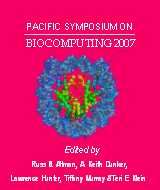New Bioinformatics Resources For Metabolomics
Markley JL, Anderson ME, Cui Q, Eghbalnia HR, Lewis IA, Hegeman A, Li J, Schulte C, Sussman M, Westler WM, Ulrich EL, Zolnai Z
Department of Biochemistry, University of Wisconsin-Madison, 433 Babcock Drive,
Madison, Wisconsin 53706, USA
Pac Symp Biocomput. 2007;:157-168.

Abstract
We recently developed two databases and a laboratory information system as resources for the metabolomics community. These tools are freely available and are intended to ease data analysis in both MS and NMR based metabolomics studies. The first database is a metabolomics extension to the BioMagResBank (BMRB, http://www.bmrb.wisc.edu), which currently contains experimental spectral data on over 270 pure compounds. Each small molecule entry consists of five or six one- and two-dimensional NMR data sets, along with information about the source of the compound, solution conditions, data collection protocol and the NMR pulse sequences. Users have free access to peak lists, spectra, and original time-domain data. The BMRB database can be queried by name, monoisotopic mass and chemical shift. We are currently developing a deposition tool that will enable people in the community to add their own data to this resource. Our second database, the Madison Metabolomics Consortium Database (MMCD, available from http://mmcd.nmrfam.wisc.edu/), is a hub for information on over 10,000 metabolites. These data were collected from a variety of sites with an emphasis on metabolites found in Arabidopsis. The MMC database supports extensive search functions and allows users to make bulk queries using experimental MS and/or NMR data. In addition to these databases, we have developed a new module for the Sesame laboratory information management system (http://www.sesame.wisc.edu) that captures all of the experimental protocols, background information, and experimental data associated with metabolomics samples. Sesame was designed to help coordinate research efforts in laboratories with high sample throughput and multiple investigators and to track all of the actions that have taken place in a particular study.[Full-Text PDF] [PSB Home Page]